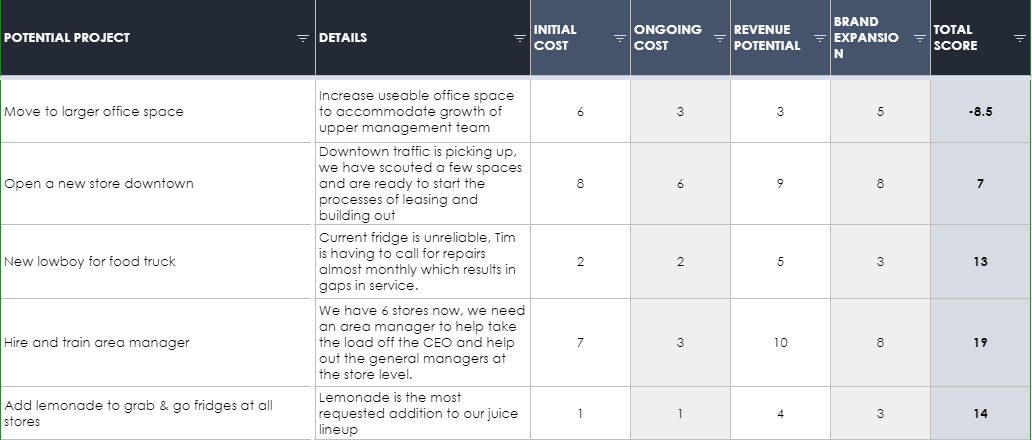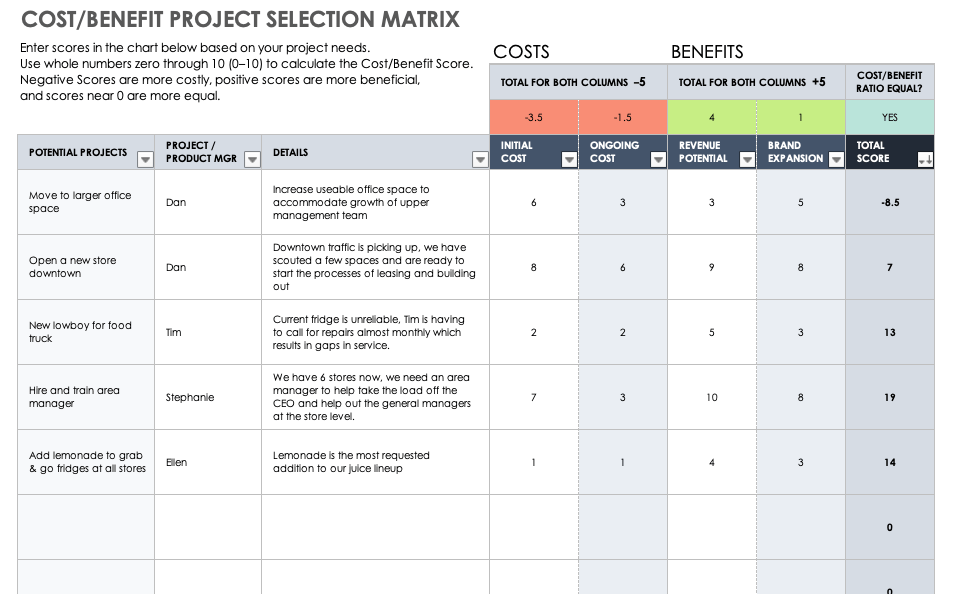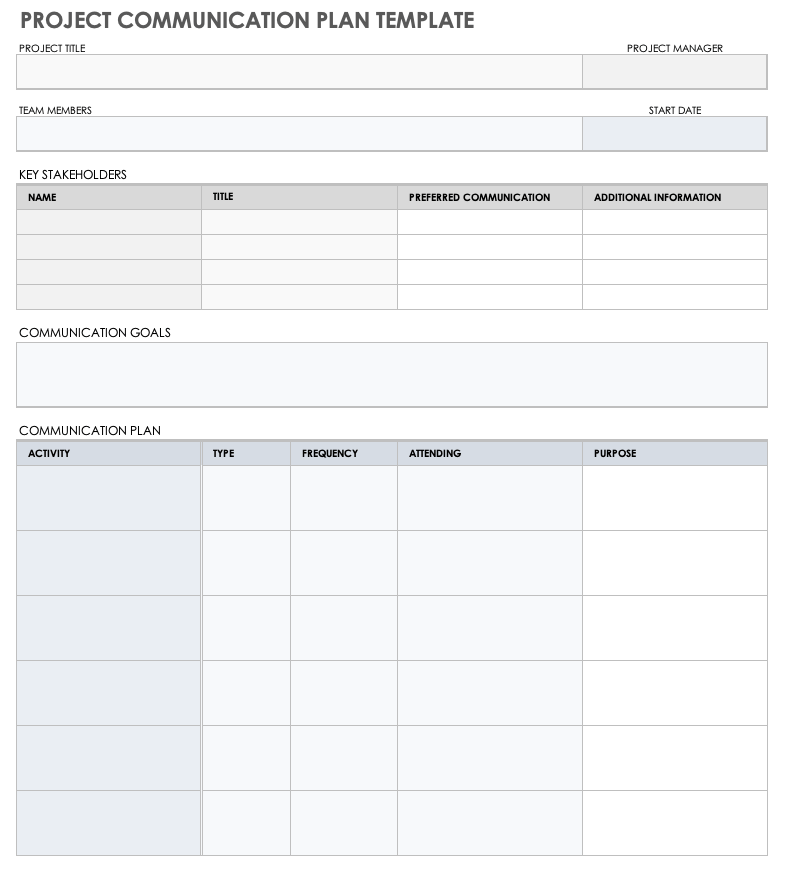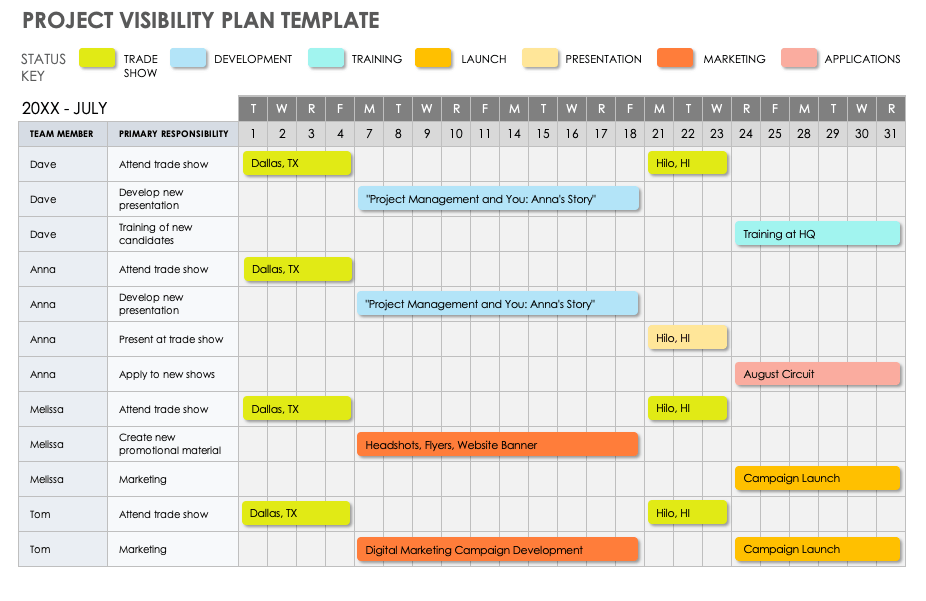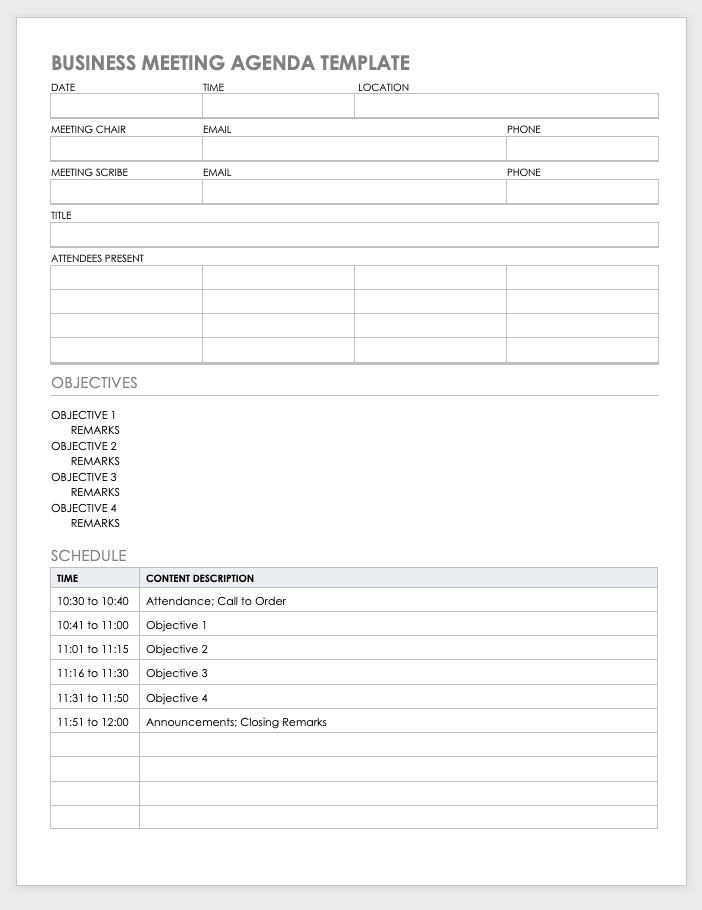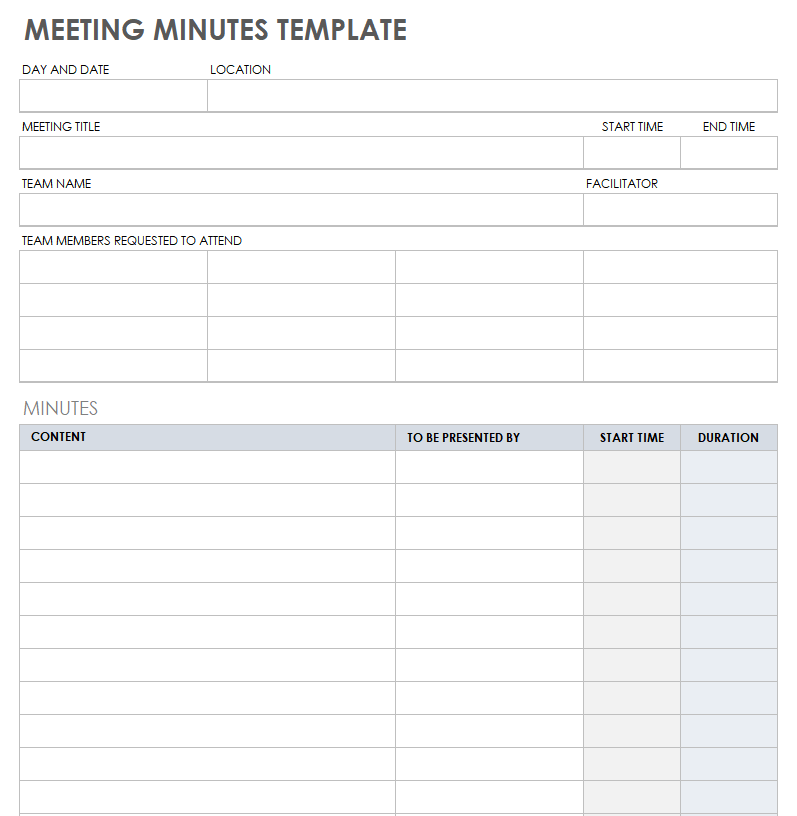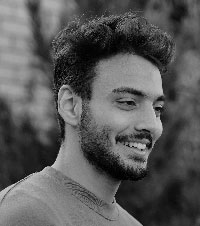What Is Project Selection and Planning?
Project selection refers to the process of outlining and choosing the next venture for a team. Projects typically compete for resources, so you must consider the demands and goals of each potential project and prioritize them accordingly.
Most organizations have several potential projects in the pipeline at any given time. Successful organizations create a standard process for comparing these projects against each other to determine the next best fit.
Once an organization chooses a project, its next steps are outlining that project and creating a project plan. For more information about general project planning, check out our guide to project plans.
Who Does the Project Selection Process?
The leaders of a company will often ultimately rank project priority, but a project manager’s expertise is also often welcome in the selection process.
Role of Project Manager in Project Selection
An experienced project manager often possesses specific knowledge and skills that a higher-level executive may not, such as more insight into the risks and resource requirements of a proposal. A project manager should also have a solid understanding of the needs and talents of your teams.
Project managers can also act as sounding boards for executives and influence the choice of the project and how it is ultimately carried out. It is important to offer unbiased input during project selection so that the whole team has the best possible chance of success.
One of the most crucial roles of a project manager is acting as the liaison between the team and the executives. Identify the most influential decision makers and their priorities for the company. When offering input, highlight your team’s strengths accordingly. At the same time, ensure that you are honest about any gaps in your team’s abilities or resources.
The role of project manager is to offer unique insight into the overall capabilities of an organization. If you believe that your company lacks the resources or time for one project, bring this up as early as possible in the planning and selection process.
Once the organization selects a project, the project manager should begin the planning process. Assemble your project plan, and create a communication plan to ensure that you and your team stay on track.
What Are the Common Management Focus Areas in Project Selection?
Management will often focus on criteria such as total budget and payback period, availability of resources, and potentials for profit and growth. Conversely, a project manager may understand factors like timeline management, risks, and the success of past projects.
It is important to understand your executives’ concerns so that you can assuage them. At the same time, know the strengths and weaknesses of your team so that you can advocate for them appropriately. The project manager should acknowledge concerns from all sides and identify and facilitate methods to remove them and ensure a successful project.
Project Selection Methods
You can use a variety of project selection methods, most of which fall into one of two categories. Constrained optimization methods prioritize numerical and mathematical advantages, while benefit measurement methods focus on more accessible concepts, such as opportunity cost and payback periods.
Constrained Optimization Methods for Project Selection
Constrained optimization methods sometimes use complex mathematical concepts to account for certain variables in the project selection process. They generally involve numbers and hard figures, and they turn real-world problems into equations to help solve them.
The following are examples of common constrained optimization methods:
- Integer Programming: This method prioritizes whole numbers over partial results. For example, a company would not want to build a partial car, only a whole car, so the determination is framed with whole cars in mind.
- Linear Programming: This method focuses on maximizing a given variable by manipulating other linear variables. For example, you can reduce the total cost of a project by reducing the time you take to complete it. If you can sell cars as fast as you can make them, you can sell more cars by making them faster.
- Dynamic Programming: This method breaks down a large problem into smaller, more manageable pieces. Instead of “building a car,” a company might focus on first building each individual piece of a car, and then putting it all together.
- Nonlinear Programming: More complex than linear programming, this method involves maximizing a given variable in a situation when other variables are not linearly tied to it. In the above car example, you may need to factor in the increased costs of expedited bulk shipping and tariffs from multiple countries when increasing your output on the assembly line.
- Multiple Objective Programming: This method is, in many ways, a combination of all of the above. Here, you create a system of functions that can help mathematically optimize your decisions. By creating equations that define the time and costs of each step of making a car, you can adjust variables as needed at any point and see a model of expected results.
Benefit Measurement Methods for Project Selection
Rather than solely focusing on the numbers, benefit measurement methods use these numbers to reflect day-to-day operations for a business. Benefit measurements relate such factors as the opportunity cost of an investment or take non-financial considerations into mind.
- Benefit-Cost Analysis: With this method, you compare the costs of a project against its benefits. Consider that a coffee shop wants to open a new location. The costs of inventory, training, hiring, and running a new location are all considerable. Still, the benefit of a new location can bring increased revenue and brand expansion, both of which are positives for the business.
- Trevor Larson is the CEO of Nectar. “The most obvious starting point when evaluating different ventures is to cost-benefit your options,” he says. “Your costs will include what you estimate to be the foregone revenue of the projects you don't prioritize.”
For more information about this concept, and downloadable templates, see our page of free cost benefit analysis templates. - Payback Period: This is the measure of the time it takes to be paid back on an initial investment. A project with a shorter payback period may be preferable to one with a longer payback period; however, it is also important to consider the project’s ongoing costs and income potential. This method is fairly simplistic in its scope, as it focuses only on cash flow and does not acknowledge any potential risks involved in the process.
In the coffee shop example, the payback period is the amount of time it takes for the new shop to make enough money to pay back the initial investment. The buildout of the space, hiring, and training of the new staff; inventory for the new store; and everything else involved with the opening must be tallied up and compared against the money the new store is making. - Discounted Cash Flow Analysis: The value of a project’s income in the future (based on factors such as inflation or the declining need of a product or service) can be an important consideration. The most beneficial projects are those that will make money for an organization long past its initial completion.
Consider that the new coffee shop is located in a great location, next to a college campus. However, you also need to consider that the students are not on campus the whole year round, and when there are fewer students, there is less revenue. - Net Present Value (NPV): Net present value is the relationship between the current cost of a project and the money it brings in, or the return on investment (ROI). A higher NPV is generally preferable, and it should always be positive. NPV considers the time value of money and takes discounted cash flow into effect over the life of a project, rather than only considering the payback period. For templates to help you calculate and track your ROI, check out “ROI Templates and Calculators for Many Disciplines.”
For example, a new coffee shop in Location A costs $25,000 to open and is expected to make $12,000 a year for the next three years. A second spot, Location B, costs the same amount to open, but is expected to make an uneven amount of money each year over the same period of time: $10,000 the first year, $15,000 the second, and $25,000 the third. With this in mind, the NPV of Location B may be preferable because the initial investment is paid back faster than the new shop in Location A. - Opportunity Cost: This figure considers the cost of a project in its entirety, not just financially. This can include the physical resources, time spent, and technical training time, as well as other factors. Opportunity cost aggregates the total cost of a project, not only the numerical costs.
For example, opportunity cost would consider the cost of moving experienced baristas from well-performing existing shops to new shops, possibly reducing the speed and quality of drinks at those stores until their replacements are trained. In this example, the owners may also lose customers who do not have time to wait longer for drinks or who feel very attached to a particular barista. - Economic Model: Every new endeavour can create financial and social capital for a company. Economic value added (EVA) is the metric that determines the financial value added to an organization by the work on or completion of a project.
A well-performing new coffee shop will increase a company’s financial assets by the revenue it generates and its potential to create future income. - Non-Financial Considerations: An organization must consider many non-financial factors when selecting a project. These can include environmental impact, social and customer impact, and adherence to company goals and values. It can be difficult to weigh these directly against financial factors, and will often also be considered.
“Non-tangible costs are just as if not more important [than financial ones],” Larson says. “A business needs to also consider whether a project is right strategically, in addition to financially. The biggest payday is not necessarily what will be best for your brand and your long-term position as an industry leader. Sometimes doing something interesting or innovative, even if the ROI is uncertain, is a better move.” - Internal Rate of Return (IRR): Lumen Learning defines the internal rate of return as the “rate of return that makes the net present value of all cash flows (both positive and negative) from a particular investment equal to zero.” This can help determine how profitable investment into a project can be by comparing the IRR of projects with the same start-up costs. A project with a higher IRR is a more profitable venture.To take the same example, the existing coffee shop needs a new espresso machine. The initial cost is $10,000, and the team expects it to save $1,500 a year on time and maintenance costs compared to the old machine. Divide the initial cost by the annual savings per year, and the IRR on this investment is 6.7 percent. Then, use this formula to estimate the IRR for different machines and compare cost savings accordingly.
- Scoring Models: This method assigns numerical values to criteria important to the business. Using a template or Excel spreadsheet, calculate the numerical score of various criteria that are important to the organization against the scores of other proposals. The higher-scoring proposal will be the project with the most relevance to the organization.
The coffee shop has multiple potential projects on the table that management needs to prioritize. The same team is in charge of both opening a new store and hiring a new area manager. After filling out the scoring model, the higher-scoring option is to hire a new area manager. Management should prioritize that task first, which will make opening the new store even easier in a few months.
What Is Project Selection Criteria?
Project selection criteria refers to the factors that a company weighs against each other to determine their next project. Considerations such as budget, timelines, and the availability of certain teams and people may contribute to this deliberation.
“Project success is measured differently for every project,” explains Marissa Taffer, PMP, Founder and President of M. Taffer Consulting. “Sometimes delivering on time, in scope, and at or under budget is a win — but often there is more to consider. Did the project accomplish what it was supposed to? Did the team work well together? What lessons did we learn?”
How Should Project Selection Criteria Be Determined?
Project selection criteria are unique to the business and the project. Generally, an organization will consider such aspects as the team’s technical prowess, the time and budget available to complete the project, and the broader scope of the organization’s goals.
“Your business evolves as your company becomes more successful. In the beginning, you take on any project, because you want to build a large company, build relevance, and gain exposure. Once you make a name, you can be a little more selective,” says Jeremy Lyman, CEO and Co-founder of Birch Coffee. “We choose projects now based on how they align with our business rather than vice versa, and we have adjusted our selection criteria accordingly.”
What Is the Project Selection Process?
The project selection process includes all activities an organization undergoes when weighing the costs and benefits of a potential venture to choose a new project. Generally, a new project is chosen and ultimately delegated to a team by high-level management.
What Are the Steps in Project Selection?
While the specific steps in the project selection may vary by organization, the process generally consists of identifying potential projects, comparing them against each other, analyzing your findings, and selecting a project.
These steps are explained in more detail as follows:
- Identify Potential Projects: Meet with the decision makers in your organization and make a list of all the next potential projects.
- Compare the Projects: Compare your potential projects using your choice of project selection method. This example uses a cost benefit template to compare the costs and benefits of the list of projects from the first step. Assign values for each criteria to compare the total scores of each project.
- Analyze Your Findings: Compare the scores of each project to determine which is best for your team. This example uses negative numbers to display a more “costly” score and positive numbers to display one that is more “beneficial.” A score near zero describes a cost benefit ratio that is closer to equal.
- Select a Project: Choose the project that best fits your team. Often, this will be the highest-scoring project. Sometimes you will also need to consider things that your model may not consider, such as budget figures and total cost.
Cost-Benefit Project Selection Matrix Template
Use this simple cost benefit template to help your team choose among the list of potential projects. Use the provided prioritization criteria, or easily customize the criteria and weights to suit your needs. This template also features customizable weights for each criteria to allocate as needed.
Download Cost Benefit Project Selection Matrix Template
What Are Project Selection Models?
Project selection models represent the structure of a project in the frame of the reason for its proposal. These non-numeric models can define projects by, for example, their necessity for competition in a market or their status as an executive’s pet project.
Below are some examples of common project selection models:
- Comparative Benefit: This model compares multiple potential projects and highlights the best among them.
- Competitive Necessity: This project is essential to the competitive edge of the business.
- Operating Necessity: The completion of this project is critical to the continued operation of the business.
- Product Line Extension: This project expands on or complements existing products within the business.
- Sacred Cow: This project was the brainchild of an important or executive member of the organization.
How Do You Choose Between Projects?
Whichever method you use for comparison, you should ultimately select the project that adds the longest-lasting value to the company. Create internal metrics for scoring or ranking, and choose the initiative that brings maximum value and costs the least over time.
“Make sure you’re taking on projects for the right reasons,” says Lyman. “People take on projects for ego or personal financial gain, and ignore red flags that they otherwise wouldn’t. For my company, that means only taking on projects that we know will align with our business strategy at the outset.”
Project Selection Facilitation Checklist
When selecting a new project, you must understand the criteria for your decision and what the project will require. We’ve created this checklist to help you stay organized and mindful of all the factors in choosing a project before you start.
Download Project Selection Facilitation Checklist - Adobe PDF
Project Communication Plan Template
This template allows you to highlight key team members, their preferred contact methods, and their communication goals. Use it to outline a meeting and communication schedule at the beginning of a new project, and keep it updated and accessible for all to see during the course of your new venture.
Download Project Communication Plan Template
Project Visibility Plan Template
Use this template to indicate what tasks each team member is currently assigned to, and when their expected start and end dates are for each one. Our example shows a team preparing for a trade show, but you can easily customize it for your needs. Ensure project visibility by making this document available to view by anyone who needs it.
Download Project Visibility Plan Template
Meeting Agenda Template
This meeting agenda template helps organize your meetings by laying out the key players involved, a schedule for the meeting itself, and the vital objectives you plan to cover. We have included a sample schedule, but you can easily change it to suit your needs.
Download Meeting Agenda Template
Microsoft Excel | Microsoft Word | Google Sheets | Adobe PDF | Smartsheet
Meeting Minutes Template
Use this template to organize your meeting notes in a cohesive and consistent way. It includes sections for meeting objectives, attendees, and notes.
Download Meeting Minutes Template
Project Management Plan Outline Template
These powerful templates are a complete kit for creating a comprehensive project plan. Use it to outline the scope of your project, list milestones, track progress, and more. Easily customize these documents to create your own fully realized plan.
Download Project Management Plan Outline Template
Facilitation Kit for Project Managers
Project managers can use this facilitation kit to help the team choose its next venture. In this downloadable kit, you will find the project selection facilitation checklist above, as well as the cost-benefit template on this page. We have also added templates to help create a project communication plan, visibility plan, and meeting schedule and notes templates to help keep you organized after your new project has been selected.
Best Practices for Project Selection
Expert-supported best practices for project selection include properly managing your resources, knowing your limits, and sticking to your business’s core strategy.
- Examine Your Available Resources:
- According to Ryan Dalal, CEO & Founder of Word to PDF, “In terms of future requirements, assess the resources available to complete the project. People, time, and money are all examples of resources. Do you have the resources you'll need to do the project on time and on a budget? This should be a major factor in deciding on a project. Projects for which you do not have enough resources may stall and become a continuing drain on your company, whereas less ambitious projects may help you get to a point where you can more easily achieve more expensive or time-consuming goals.”
- Consider the Scope: “I think the most important thing when selecting a project is getting clear on what the project actually is,” says Taffer. “For example, one of the biggest projects I ever worked on was actually about six projects over the course of a year. Creating a clear critical path, communicating resources at each phase, and aligning all stakeholders on the schedule was complicated. Many stakeholders didn’t understand why certain activities were prioritized and when. Having a strong kick-off meeting and discussing project and priorities before undertaking such a large group of projects was the most important thing we could have done.”
- Consider Your Business Objectives: Make sure that your projects fit your business strategy. “If we think a particular project will move us in an agreed-upon strategic direction — whether that is as the provider of a unique product or the best customer service in the industry — we will typically go with that option,” Larson explains.
- Review Existing Projects: “I use a scorecard method,” says Taffer. She explains that doing so worked well at a previous employer, for two key reasons: “First, it held us accountable to complete the work we said we were going to. Secondly, it prevented what I call ‘shiny object syndrome.’ If something new came up during the year, we would have to measure it against the scorecard and decide where it fit. We would either have to move something from the scorecard, adjust scope, or determine that this new initiative would need to wait until the next year. Having these more strategic conversations helped us make better business decisions and kept everyone clear on what outcomes to expect by year end.”
- Involve the Team: Ask your staff for input. “The last thing you want to do is frustrate the team,” says Lyman, “Once people end up frustrated, you need to backpedal and waste time. We also don’t want to overwhelm people with new tasks, especially when they have a lot on their plate. If we’re constantly throwing things at people, it can lead to them feeling uninformed and burned out. Start small, start slow, and build up from there.”
- Choose Your Selection Criteria Thoughtfully: Different criteria matter more for some projects than they for others. Make sure that you compare projects by the criteria that make the most sense for your organization and the specific projects in question.
- Compare Multiple Methods: Some selection methods are limited in scope. For instance, you might have two projects that score the same on a cost benefit model, but the initial cost for one might be out of the current budget. To gain perspective, compare both scoring models and actual budget numbers when assessing projects that differ significantly in size or importance.
- Know Your Limits: “Know when to stop taking on new projects, and when to say no to taking on new customers or partners,” advises Thomas Fultz, CEO and Founder of Coffeeble. “This is the boundary that any leader should have at work, so that they can manage the quality of the current project to the fullest capacity.”
- Don’t Rush It: “Once you start a new project, when possible, start small,” suggests Lyman. “This allows you to work together with new companies more easily until you form an understanding of how you work together. There’s no rush. You want to make sure you get it right, and it’s important to make sure you take the time you need to get it right.”
History of Project Selection
Project management has been recognized as a discipline since the mid-1950s. The American Association of Cost Engineers (AACE) was founded in 1956; this marked the beginning of the standardized practices of scheduling, cost engineering, and project selection.
In 1958, the United States Navy developed the Program Evaluation Review Technique (PERT). With it, managers can better estimate the length of time each phase of a project will take, which gives them a better sense of a project’s timeline. Using PERT and the critical path method (CPM), which was developed in 1957, organizations can compare projects to each other based on the time commitment they would take to execute.
The Project Management Institute (PMI) was founded in 1969, and in 1996, the organization published “A Guide to the Project Management Body of Knowledge (PMBOK),” outlining best practices for project managers, regardless of their field. As the AACE evolved, the organization developed new tools for estimating cost and risk level involved in potential projects. In 2006, it established the concept of integrated total cost management. Combined, these methods and guides produce a range of tools to make project selection simpler and more thorough today.
Streamline the Project Selection Process with Real-Time Work Management in Smartsheet
Empower your people to go above and beyond with a flexible platform designed to match the needs of your team — and adapt as those needs change.
The Smartsheet platform makes it easy to plan, capture, manage, and report on work from anywhere, helping your team be more effective and get more done. Report on key metrics and get real-time visibility into work as it happens with roll-up reports, dashboards, and automated workflows built to keep your team connected and informed.
When teams have clarity into the work getting done, there’s no telling how much more they can accomplish in the same amount of time. Try Smartsheet for free, today.




